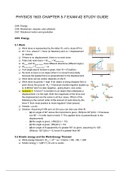10/20/2018 Untitled document - Google Docs
https://docs.google.com/document/d/13HKw0BPTDcHZU4wwttU0a80YxB8ngAB4hAK9QOdbT30/edit 1/11PHYSICS 1603 CHAPTER 5-7 EXAM #2 STUDY GUIDE CH5: Energy CH6: Momentum, impulse, and collisions CH7: Rotational motion and gravitation CH5: Energy 5.1 W ork ❏Work done is represented by the letter W, unit is Joule (N*m) ❏W = F ∆x, where F = force (in Newtons) and ∆x = displacement (in meters) ❏If there is no displacement, there is no work done ❏Total (net) work done = W Force + W Kinetic friction ❏W Force and W Kinetic friction have different directions (different signs) ❏W Kinetic friction = F Kinetic friction * ∆x ❏If an angle above horizon is given, then W = (Fcosθ)∆x ❏No work is done on an object when it is moved horizontally because the applied force is perpendicular to the displacement ❏Work done can be varied, depends on the θ ❏Work done by gravity = mgh: If an object is being dropped from a point above the ground, W g > 0 because double-negative applies (g is -9.80m/s 2 and h is also negative - going down), vice versa ❏Question 1 : A force F is exerted on an object that undergoes a displacement x to the right. Both the magnitude of the force and the displacement are the same in all four cases. Which of the following is the correct order of the amount of work done by the force F, from most positive to most negative? (See picture) ❏Answer: c,a,d,b ❏Solution: Assuming F=5N and ∆x=2m (you can also use other #) -(a) An angle of 90 ° above the horizontal is given, (5N)(cos 90°)(2m) = 0 because cos 90° = 0 (refer back to block 7! The applied force is perpendicular to the displacement) -(b) No angle is given, (-5N)(2m) = -10J -(c) No angle is given, (5N)(2m) = 10J -(d) An angle of θ (apparently it’s greater 90°) is given, assuming it’s 120°, (5N)(cos 120°)(2m) = -5J since θ is greater than 90° 5.2 Kinetic energy and the W ork-Energy Theorem ❏Work-energy theorem: W net = ∆F * ∆x = (ma)∆x = KE f - KE i = ∆KE ❏Kinetic energy = ½(M*V 2 ), SI unit is Joules 10/20/2018 Untitled document - Google Docs
https://docs.google.com/document/d/13HKw0BPTDcHZU4wwttU0a80YxB8ngAB4hAK9QOdbT30/edit 2/11❏If an object’s speed is doubled, its kinetic energy will be affected by a factor of 4 ❏Constant/unchanged speed = no net work done ❏Question 2 (similar to example 34) : A force of 20.0N is exerted on a 3.0kg object that is moving to the right, has a displacement of 5.0m, while the coefficient of kinetic friction is 0.15. (a) Find the work done by applied force, F (b) Find the work done by the friction (c) What is the net work done on this object? (d) What is the speed of the object after moving 5.0m? ❏Answer: (a) 100J (b) -22.1J (c) 78.0J (d) 7.21m/s ❏Solution: -(a) W force = F∆x = (20.0N)(5.0m) = 100J -(b) W Kinetic friction = (-F Kinetic friction )∆x = (0.15)(3.0kg)(-9.80m/s 2 )(5.0m) = -22.05J ●Why? Because F Kinetic friction = μF normal and F normal = mg -(c) W net = W force + W Kinetic friction = 100+(-22.05) = 77.95 = 78.0J -(d) W net = ∆KE, ½(M*V 2 ) = 78.0J, where M = 3.0kg, you get V 2 = 52m 2 /s 2 = V = 7.21m/s 5.3 Gravitational Potential Energy ❏Potential energy: energy caused by its position, unit is Joules, PE = mgh, h is the height (displacement) ❏Energy cannot be created nor destroyed ❏When an object is thrown up, it has no kinetic energy at its highest point, similarly, when an object is dropped, it has no potential energy (see ex. 35) ❏Applying Conservation of Mechanical Energy to problems 1.Define the system, including all interacting bodies. Verify the absence of nonconservative forces. 2.Choose a location for y=0 , the zero point for gravitational potential energy 3.Select the body of interest and identify two points—one point where you have given information and the other point where you want to find out something about the body of interest 4.Write down the conservation of energy equation for the system. Identify the unknown quantity of interest 5.Solve for the unknown quantity, which is usually either a speed or a position, and substitute known values ❏Question 3 (similar to ex. 37) : A 2.0 kg block is on an 10.0m inclined plane of 30°, assuming the coefficient of kinetic friction is 0.15, find the net work done and the velocity of block at the bottom. ❏Answer: 72.5 J and 8.51m/s ❏Solution: -Height of the inclined plane = 10.0m(cos 30°) = 5.0m - pythagorean theorem -Net work done = W gravity + W Kinetic friction




